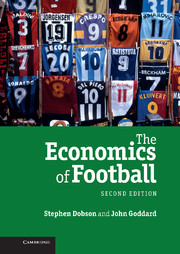Book contents
- Frontmatter
- Contents
- Preface
- Acknowledgements
- List of figures
- List of tables
- 1 Introduction
- 2 The economic theory of professional sports leagues
- 3 Competitive balance, uncertainty of outcome and home-field advantage
- 4 Forecasting models for football match results
- 5 Game theory and football games
- 6 English professional football: historical development and commercial structure
- 7 Determinants of professional footballers' salaries
- 8 Professional footballers: employment patterns and racial discrimination
- 9 The football manager
- 10 The football referee
- 11 Spectator demand for football
- 12 Gambling on football
- 13 Football around the world: France, Germany, Brazil, Japan and China
- 14 The economics of the World Cup
- References
- Index
2 - The economic theory of professional sports leagues
Published online by Cambridge University Press: 05 June 2012
- Frontmatter
- Contents
- Preface
- Acknowledgements
- List of figures
- List of tables
- 1 Introduction
- 2 The economic theory of professional sports leagues
- 3 Competitive balance, uncertainty of outcome and home-field advantage
- 4 Forecasting models for football match results
- 5 Game theory and football games
- 6 English professional football: historical development and commercial structure
- 7 Determinants of professional footballers' salaries
- 8 Professional footballers: employment patterns and racial discrimination
- 9 The football manager
- 10 The football referee
- 11 Spectator demand for football
- 12 Gambling on football
- 13 Football around the world: France, Germany, Brazil, Japan and China
- 14 The economics of the World Cup
- References
- Index
Summary
Introduction
As seen in Chapter 1, the idea that market mechanisms can be relied upon to maintain a reasonable degree of competitive equality among the member teams of a sports league, without the need for extensive regulation of player compensation or mobility by the sport's governing body, was first articulated by Rottenberg (1956). In discussing the economic structure and characteristics of the North American baseball players' labour market, Rottenberg considers the case of two teams located in different towns, one of which has a larger population (or potential market) than the other. Other things being equal the marginal revenue product of a player of a given level of ability is greater with the large-market team than it is with the small-market team. Since the marginal revenue function declines as the quantity of playing talent already held increases, however, it does not pay the large-market team to accumulate the most talented players to the point where complete competitive dominance is achieved.
This argument does not depend upon contractual arrangements or the structure of player compensation. It is valid under free agency, in which case the player may be in a strong position to secure most or all of his marginal revenue product in salary negotiations, since his reservation wage is the salary he could command by signing for another team.
- Type
- Chapter
- Information
- The Economics of Football , pp. 12 - 41Publisher: Cambridge University PressPrint publication year: 2011



